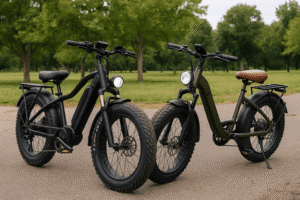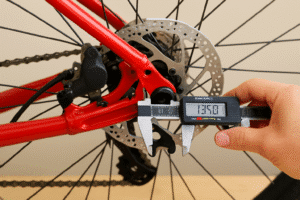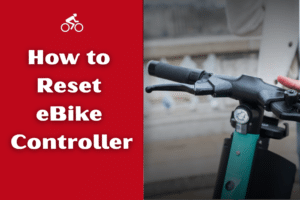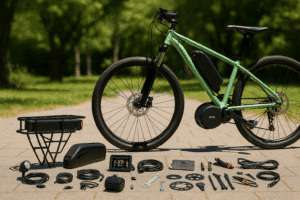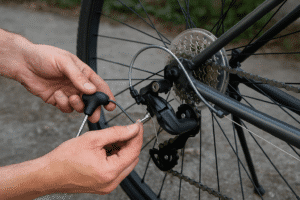If you’re wondering how much does an e-bike weigh, the answer depends on a few key things, like the frame design, motor size, and what kind of riding it’s built for.
Most e-bikes weigh more than a regular bicycle, but not all of them are bulky or hard to lift.
This guide breaks it down by category so you know exactly what to expect based on how you plan to ride.
TL;DR – How Much Does an E-Bike Weigh?
- Most e-bikes weigh 40–80 pounds (18–36 kg)
- Battery adds 6–10 lbs depending on size
- Lighter models (like folding or carbon-frame bikes) can weigh under 40 lbs
- Heavier builds (cargo, fat-tire, hunting e-bikes) can exceed 90 lbs
- Weight impacts range, transport, and lifting, not riding performance
- You can reduce weight by removing the battery or skipping extras like racks and baskets
How Much Do E-Bikes Weigh on Average?
Most e-bikes weigh between 40 and 80 pounds, including the battery. Lighter models like folding or carbon-frame e-bikes can dip below 40 pounds, while heavy-duty cargo and fat tire e-bikes can exceed 80 pounds.
E-bikes are heavier than regular bicycles because they include motors, batteries, and reinforced frames. A traditional bike might weigh 25–30 pounds, but a commuter or mountain e-bike can add 15–30 pounds on top of that.
The battery alone adds about 6–10 pounds, depending on capacity.
The good news is that you rarely feel the weight while riding. Pedal assist systems make up for the added load, so handling stays smooth and responsive.
You’ll notice the weight more when lifting it onto a rack or carrying it indoors.
E-Bike Weight by Type (Chart + Breakdown)
Different e-bike types are built for different jobs, and that affects how much they weigh. Here’s a quick comparison.
| E-Bike Type | Avg. Weight (lbs) | Best For |
| Folding | 30–50 | Portability and travel |
| Road/Racing | 35–45 | Speed and efficiency |
| Commuter/Hybrid | 50–70 | Daily city riding |
| Mountain (eMTB) | 50–75 | Trails and off-road use |
| Fat Tire | 60–80+ | Sand, snow, rugged terrain |
| Cargo/Utility | 70–90+ | Hauling gear or passengers |
| Cruiser/Comfort | 60–75 | Relaxed, casual rides |
Folding E-Bikes
Folding e-bikes weigh around 30–50 pounds, depending on the motor and tire type. They’re built for easy storage and transport, often with smaller wheels and compact frames.
Perfect for apartment dwellers, train commuters, or RV travelers.
Road and Racing E-Bikes
These are some of the lightest, averaging 35–45 pounds. Designed for speed and long-distance efficiency, they use thinner tires, carbon or aluminum frames, and smaller motors.
Commuter and Hybrid E-Bikes
These fall in the 50–70 pound range. They balance comfort and utility, often including racks, fenders, and mid-sized motors. Popular for everyday riding and mid-range trips.
Mountain (eMTB) E-Bikes
Most electric mountain bikes weigh between 50 and 75 pounds. The suspension, knobby tires, and robust motors make them ideal for trails and hills, but all that adds weight.
Fat Tire E-Bikes
These bikes come in at 60–80+ pounds. The wide tires help with traction in sand, snow, or gravel, but require powerful motors and sturdy frames to handle the extra drag.
Cargo and Utility E-Bikes
These are the heaviest, often 70–90+ pounds. Designed to carry kids, groceries, or gear, they come with extended frames and large batteries. Some models even use dual motors.
Cruiser and Comfort E-Bikes
Typically 60–75 pounds, cruiser bikes offer upright riding, wide handlebars, and cushy seats. They’re made for relaxed neighborhood rides and beachside cruising.
What Adds Weight to an E-Bike?
The biggest contributors to an e-bike’s weight are the battery, motor, and frame material.
While regular bikes keep things minimal, e-bikes pack in extra components to give you power and range. Here’s what adds up:
- Battery (6–10 lbs): Bigger batteries offer longer range but weigh more. A 500Wh battery is usually heavier than a 300Wh one.
- Motor (4–7 lbs): Mid-drive motors weigh more than rear hub motors but provide better balance and climbing power.
- Frame material: Steel is strong but heavy, aluminum offers a good balance of weight and cost, and carbon fiber is the lightest but also the most expensive.
- Tires: Wide or fat tires weigh more and need stronger support.
- Suspension: Full-suspension systems on mountain and fat bikes add several pounds.
- Accessories: Racks, baskets, fenders, lights, and displays all add a bit. Over time, they can stack up.
Even though all these pieces add weight, they’re what make e-bikes powerful and practical.
If you’re worried about lifting or hauling the bike, opt for models with removable batteries or a lighter frame.
Does E-Bike Weight Affect Performance?
E-bike weight can affect performance in terms of range, handling, and transport, but not pedal-assist power. Thanks to the motor, you won’t feel much of the extra weight while riding, especially on flat terrain.
That said, heavier bikes generally use more battery power, especially when climbing hills or accelerating. This can shorten your total range by a few miles compared to a lighter model with the same battery. The placement of the weight also matters.
A centrally mounted motor and battery give better balance, while a rear-heavy setup might feel awkward when turning or climbing.
Outside of riding, weight becomes a bigger factor when you need to lift the bike, transport it in a car, or carry it upstairs. That’s when every extra pound makes a difference.
Can You Make an E-Bike Lighter?
You can make an e-bike lighter by removing accessories, swapping components, or choosing a smaller battery. While you can’t change the core weight of the frame easily, you can reduce total load with a few smart adjustments.
Here are some simple ways to cut down your e-bike’s weight:
- Remove the battery when lifting or transporting: Saves 6–10 pounds instantly and makes loading much easier.
- Ditch unnecessary accessories: Racks, baskets, bags, and extra lights all add up.
- Switch to narrower tires: Lighter tires reduce rolling resistance, though you’ll lose some grip.
- Use lightweight components: Consider upgrading the seatpost, saddle, or pedals to lighter versions.
- Downsize your battery: If you don’t need long range, a smaller-capacity battery will weigh less.
- Pick a model with a minimalist design: City or racing e-bikes with smaller motors and fewer features tend to weigh the least.
If portability is a priority, a folding e-bike or a carbon-frame model might be a better fit. But remember, shaving off too much weight often means sacrificing comfort, power, or range.
When Does E-Bike Weight Really Matter?
E-bike weight matters most when you’re lifting, transporting, or trying to maximize range. During normal riding, the motor offsets much of the extra load, but off the bike is where things get tricky.
For example, if you need to carry your e-bike up stairs, onto a rack, or into a vehicle, every pound makes a difference.
Lifting a 75-pound fat-tire e-bike isn’t easy, especially if the battery is still attached. If you live in an apartment or travel often, a lighter model is worth considering.
Weight also impacts range. A heavier frame puts more demand on the motor and battery, especially when climbing hills or riding with cargo.
If you’re aiming for long-distance rides, choosing a balanced setup with good weight distribution can help maintain efficiency without draining your battery too quickly.
Should You Worry About the Extra Weight?
You don’t need to worry about an e-bike’s weight while riding, but it’s something to consider for storage, transport, and daily use. The pedal assist handles most of the workload on the road, so the bike won’t feel heavy when you’re moving.
That said, the extra weight becomes more noticeable when you’re pushing the bike manually, carrying it up steps, or loading it into a vehicle. If you have limited upper body strength or tight storage spaces, choosing a lighter model might save you daily hassle.
In the end, it depends on your lifestyle and how you plan to use the bike. For city commuters, weight might be a bigger factor.
For trail riders or cargo haulers, power and durability might matter more than pounds. So it’s less about worrying and more about matching the bike’s weight to your needs.
Final Words
E-bikes weigh more than traditional bicycles, but for good reason. That extra weight comes from the motor, battery, and frame reinforcements that give you pedal assist, range, and ride comfort.
Most models fall between 40 and 80 pounds, though that can vary quite a bit depending on the type of bike and how it’s built.
If you’re comparing options, think about how and where you’ll be using the bike. Commuters might prioritize portability and ease of lifting. Off-road riders may need power and stability over low weight.
The key is finding the right balance for your needs, something that feels good to ride and makes your daily trips easier, not harder.
FAQs
How heavy is an average e-bike?
Most e-bikes weigh between 40 and 80 pounds, including the battery. Lighter models can weigh under 40 lbs, while cargo and fat-tire bikes can go over 90 lbs.
Why are e-bikes heavier than regular bikes?
E-bikes are heavier because they include a motor, battery, reinforced frame, and electronic components that regular bikes don’t have.
What’s the lightest electric bike available?
The lightest e-bikes on the market weigh around 30 to 35 pounds, usually using carbon fiber frames and small batteries. These models tend to be more expensive.
Does a heavier e-bike mean less range?
Yes, slightly. Heavier bikes require more energy, so they may get fewer miles per charge compared to lighter ones with the same battery.
Can I put an e-bike on a car rack?
Yes, but check the weight rating of the rack first. Many standard bike racks support up to 60–70 lbs per bike, so removing the battery before transport is a smart move. Some racks are built specifically for e-bikes.
Al Amin Morshed is the founder of BoltBikers and a seasoned e-bike reviewer with years of hands-on experience testing electric bikes. As a long-time e-bike enthusiast, he combines real-world riding insights with in-depth research to create honest, helpful content for riders of all levels. Through BoltBikers, Morshed aims to make e-biking more accessible, practical, and enjoyable – whether you’re a new rider or a daily commuter looking for the best gear.


